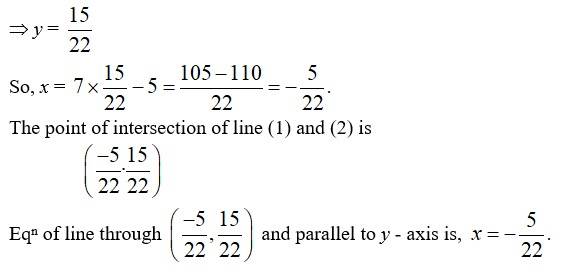Maths
Get insights from 6.5k questions on Maths, answered by students, alumni, and experts. You may also ask and answer any question you like about Maths
Follow Ask QuestionQuestions
Discussions
Active Users
Followers
New answer posted
6 months agoContributor-Level 10
f: R → R is given as f (x) = x3.
Suppose f (x) = f (y), where x, y ∈ R.
⇒ x3 = y3 … (1)
Now, we need to show that x = y.
Suppose x ≠ y, their cubes will also not be equal.
⇒ x3 ≠ y3
However, this will be a contradiction to (1).
∴ x = y
Hence, f is injective.
New answer posted
6 months agoContributor-Level 10
It is given that is defined as
Suppose , where
Since x is positive and y is negative:
But, 2xy is negative.
Then, .
Thus, the case of x being positive and y being negative can be ruled out.
Under a similar argument, x being negative and y being positive can also be ruled out
x and y have to be either positive or negative.
When x and y are both positive, we have:
When x and y are both negative, we have:
is one-one.
Now, let such that .
If x is negative, then there exists such that
If x is positive, then there exists such that
is onto.
Hence, f is
New answer posted
6 months agoContributor-Level 10
60. The given eqn of lines are
x - 7y + 5 = 0 ______ (1) ⇒ x = 7y - 5
and 3x + y = 0 _________ (2)
Solution (1) and (2) we get,
3 [7y – 5] + y = 0 .
⇒ 21y - 15 + y = 0
⇒ 22y = 15

New answer posted
6 months agoContributor-Level 10
It is given that:
is defined as
One-one:
Let,
It can be observed that if n is odd and m is even, then we will have n-1=m+1.
However, the possibility of n being even and m being odd can also be ignored under a similar argument.
Both n and m must be either odd or even.
Now, if both n and m are odd, then we have:
Again, if both n and m are even, then we have:
is one-one.
It is clear that any odd number 2r+1 in co-domain N is the image of 2r in domain N and any even 2r in co-domain N is the image of 2r+1 in domain N.
is onto.
Hence, f is an invertible function.
Let us define as:
Now, when n is odd:
And, when
New answer posted
6 months agoContributor-Level 10
25. Given, f(x)=
f(x)={(0,0),(1,1),(2,4),(3,9),(4,12),(5,15),(6,18),(7,21),(8,24),(9,27),(10,30)}
So, the elements in domain of f has one and only one image.
? f(x) is a function.
Given, g(x)= .
g(x)={(0,0),(1,1),(2,4),(2,6),(3,9),(4,12),(5,15),(6,18),(7,21),(8,24),(9,27),(10,30)}
So, the element 2 of the domain has more than one image i.e., 4 and 6.
? g(x) is not a function.
New answer posted
6 months agoContributor-Level 10
It is given that is defined as
One-one:
is a one-one function.
Onto:
Therefore, for any ,there exists
Such that
is onto.
Therefore, f is one-one and onto.
Thus, f is an invertible function.
Let us define as
Now, we have
Hence, the required function is defined as
New answer posted
6 months agoContributor-Level 10
On N, the operation * is defined as a * b = a3 + b3.
For, a, b, ∈ N, we have:
a * b = a3 + b3 = b3 + a3 = b * a [Addition is commutative in N]
Therefore, the operation * is commutative.
It can be observed that:
(1*2)*3 = (13+23)*3 = 9 * 3 = 93 + 33 = 729 + 27 = 756
Also, 1* (2*3) = 1* (23 +33) = 1* (8 +27) = 1 * 35
= 13 +353 = 1 + (35)3 = 1 + 42875 = 42876.
∴ (1 * 2) * 3 ≠ 1 * (2 * 3) ; where 1, 2, 3 ∈ N
Therefore, the operation * is not associative.
Hence, the operation * is commutative, but not associative. Thus, the correct answer is B.
New answer posted
6 months agoContributor-Level 10
(i) Define an operation * on N as:
a * b = a + b a, b ∈ N
Then, in particular, for b = a = 3, we have:
3 * 3 = 3 + 3 = 6 ≠ 3
Therefore, statement (i) is false.
(ii) R.H.S. = (c * b) * a
= (b * c) * a [* is commutative]
= a * (b * c) [Again, as * is commutative]
= L.H.S.
∴ a * (b * c) = (c * b) * a
Therefore, statement (ii) is true.
Taking an Exam? Selecting a College?
Get authentic answers from experts, students and alumni that you won't find anywhere else
Sign Up on ShikshaOn Shiksha, get access to
- 65k Colleges
- 1.2k Exams
- 679k Reviews
- 1800k Answers
